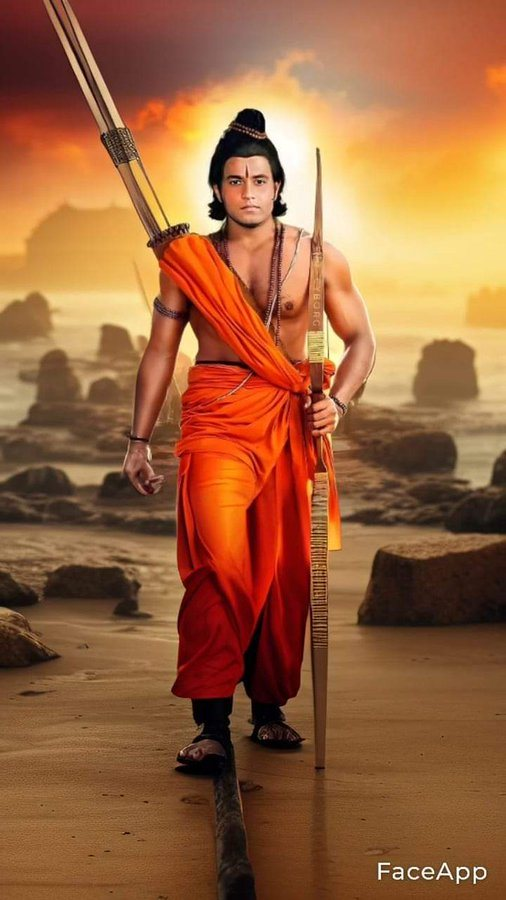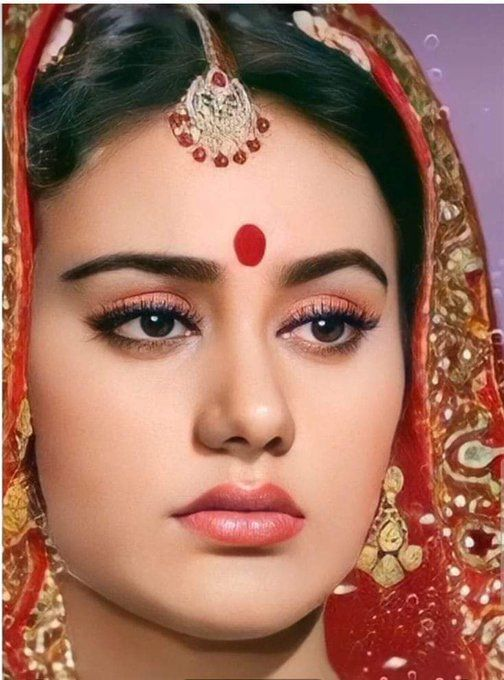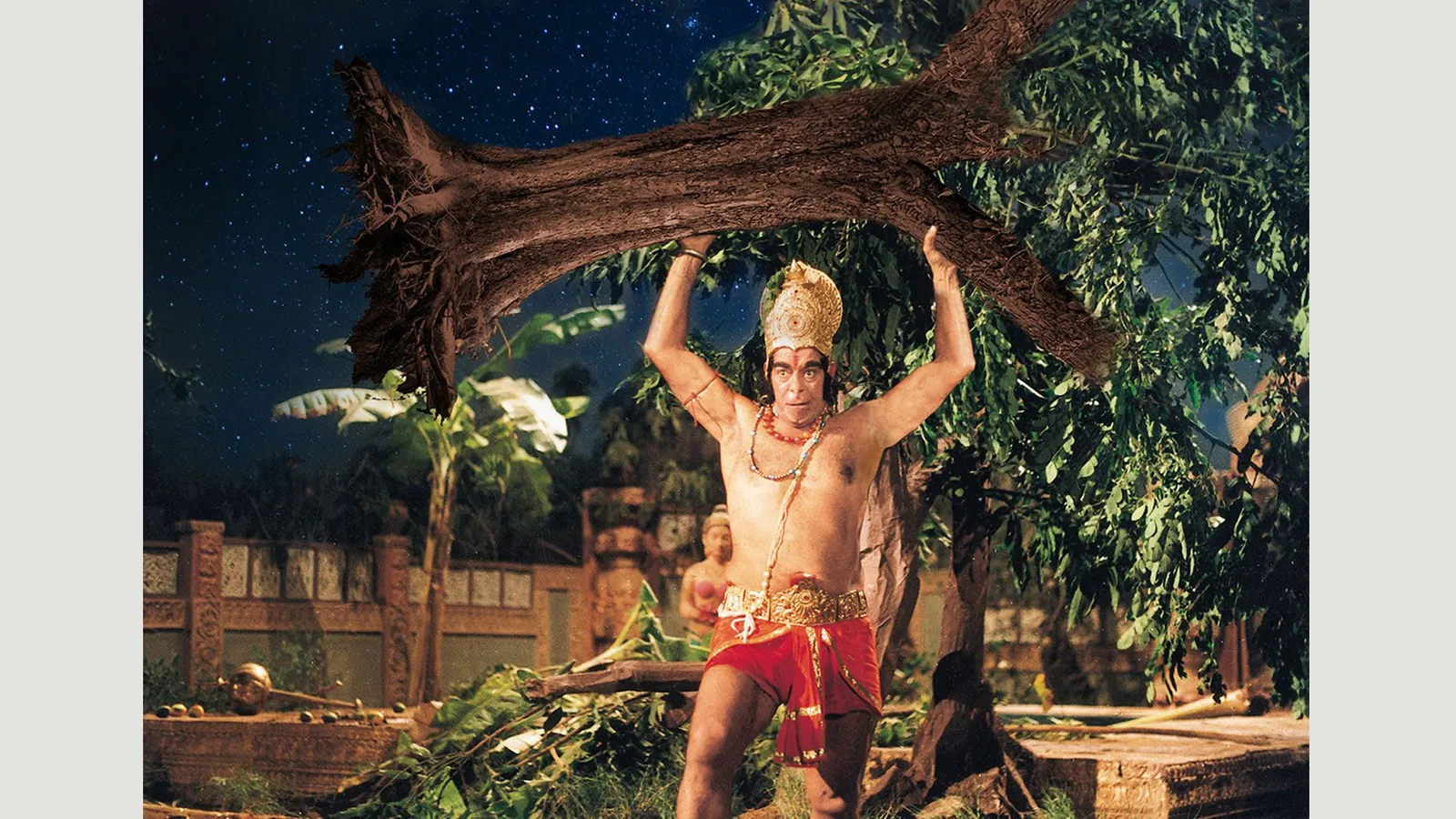The largest campaign for one religion and its heroes and Gods took place in post-Independence India. It was a new beginning. It irrevocably changed the complexion of Indian politics but did it slowly.
The telecast of a religious epic to popular acclaim created the sense of a nation coming together, it was on the same page of BJP's idea of 'Hindu awakening'.
My communist cousins in Kolkata disapproved BJP; but their houses too ran the serials religously.
Ramayan serial : Lord Ram (Arun Govil) marries Sita (Deepika Chikhalia) after proving himself heroic in a contest against other suitors - a pre-condition put by Sita's father King Janak
Deepika Chikhlia was 'Sita' of Doordarshan's first mega epic serial 'Ramayana' (1987), Arun Govil had played Ram and it may be mentioned that in 1989 Lok Sabha elections, Congress used Govil for campaigning....
Religion was then electronic opium !
Arun Govil and the Congress courted controversies when he used to say during campaigning, "I am here to bless you (as Ram) and I desire you should vote for the Congress".
Sita/Deepika joined BJP and became Lok Sabha MP. Arvind Trivedi, who played Ravana also became a BJP lawmaker.
Arvind Trivedi alongside his brother Upendra Trivedi, was prolific in Gujarati cinema for over 40 years.
He naturally became a household name for playing the role of Ravana in television series Ramayan.
He was elected to the Lok Sabha, lower house of the Parliament of India from Sabarkantha, Gujarat as a member of the Bharatiya Janata Party, in 1991 elections. Actress Deepika also was a member of the 10th Lok Sabha between 1991 and 1996. She represented Baroda also in Gujarat.
In 1988 Nitish Bharadwaj was selected to play the lead role of Lord Krishna in B. R. Chopra's classic television series 'Mahabharat'. Overnight he shot into fame for playing the role of Lord Krishna at the age of 23 .
He became BJP MP from Jamshedpur then part of united Bihar. He had defeated veteran Inder Singh Namdhari.
But later in 1999, he lost to Laxman Singh (brother of then chief minister of Madhya Pradesh, Digvijaya Singh) from Rajgarh constituency.
He also worked in BJP's organisational unit of Madhya Pradesh and was also its spokesperson for a while.
Bengali actress Roopa Ganguly is best known for her portrayal of 'Draupadi' in B R Chopra's 'Mahabharat'.
She came into politics and joined the BJP many years later. She became Rajya Sabha member nominated and was MP between October 4, 2016 and April 24, 2022. She has been quite articulate and emerged as a vocal critic of Mamata Banerjee.
She also served as the president of BJP Mahila Morcha, West Bengal between
2015 and 2017.
In 2011, she received the National Film Award for Best Female Playback Singer for rendering her voice in Aditi Roy's Bengali film 'Abosheshey'
Ace director Goutam Ghose once said that "she has that skill to transform herself into any character she plays."
We were in Nagaland (Kohima) those days and every Sunday morning was booked for the serials. As a story, personally I always liked Mahabharat. Yet Ramayana would also attract every Hindu - we knew before the idiot box.
My daughter's generation, Gen Z, may not understand or imagine .... our TV set was black and white. Nevertheless attraction remained.
The BBC’s Delhi correspondent Soutik Biswas wrote in 2011: “I remember the soap nearly shutting down India on Sunday mornings in the mid-1980s – streets would be deserted, shops would be closed and people would bathe, and garland their TV sets before the serial began.”
I cannot agree more. Me and my brother landed at Howrah station one Sunday and the timing was morning show for Mahaabharat. West Bengal was strongly under Jyoti Basu's grip and yet roads were deserted and hurriedly we could reach our aunt's house not to miss the show.
One Sunday, during Mahabharat timing, Ihad landed in Shivpur's engineering college and there too, students had gathered at the recreation hall for Mahabharat show. That day, if I am not mistaken --- Abhimanyu, Arjun's son, was killed.
In a 2000 interview with 'Frontline' magazine, Arvind Rajagopal of New York University had said that when the Indian government began broadcasting the Ramayan to nationwide audiences, “This violated a decades-old taboo on religious partisanship, and Hindu nationalists made the most of the opportunity.
"What resulted was perhaps the largest campaign in post-Independence times, irrevocably changing the complexion of Indian politics. The telecast of a religious epic to popular acclaim created the sense of a nation coming together, seeming to confirm the idea of Hindu awakening.”
It is true as one BBC article later said, while it was the Congress government of the time that sought to capture Hindu votes by broadcasting the 'Ramayan' on state TV channel Doordarshan, it is the Hindu nationalist party, the BJP that has reaped the benefits.
Rajagopal explains the phenomenon very well. “The broadcast of the Ramayana was the first major rupture of the secular consensus, it catered to the devout and ritualistic. The popular response was devotional, but the activity of political parties was necessary to translate that into something political.”












Fantastic memories. Yes those two TV serials actually brought the country to a standstill during the times those were broadcast. So much so that in those days I used to curse the electricity department if there was power outage. Those were not the days of having inverter in middle class homes
ReplyDeleteActually I haven't heard something like inverter existed. I only knew about generators one day while watching Ramayan power went off. We were living in a rented house then. I soon realized owner of the house was watching TV, which meant there was B no power outage.there were four other families who stayed on rent in a rail coach like construction. Then I began looking for the main fuse box through which the power was distributed to the families stay6on rent. I realized that the fuse had gone off due to overload. The fuse was just outside the door of a Sardar family. The head of the family was Msc in physics and he began scolding me when I tried to remove the fuse to fix wire so that current would pass again. He was very sceptical of doing it instead he suggested me to call for an electrician. But I knew how to to fix the wire and I made it a point to prove. I didn't want to miss the serial. Those days fuse were made of porcelain. Today's generation wouldn't know about those. Today fuse switch drops down and we just push it up to restore the power 😊😊 - K. Patil, Pune